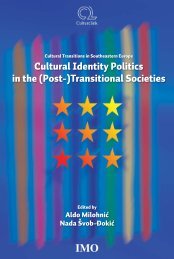D:\Documents and Settings\Ana\My Documents\Biserka-knjiga ...
D:\Documents and Settings\Ana\My Documents\Biserka-knjiga ...
D:\Documents and Settings\Ana\My Documents\Biserka-knjiga ...
You also want an ePaper? Increase the reach of your titles
YUMPU automatically turns print PDFs into web optimized ePapers that Google loves.
Digital culture in policy documents<br />
• establishing one-stop-shop Internet access for the entire range of Slovenian<br />
cultural heritage <strong>and</strong> culture, connected to the European digital library <strong>and</strong> other<br />
places storing digital cultural content around the world.<br />
Economies of scale place smaller language groups at a disadvantage <strong>and</strong> threaten<br />
the preservation <strong>and</strong> promotion of smaller cultural spaces <strong>and</strong> their identities. To<br />
ensure a “socially optimal” level of development <strong>and</strong> usage of quality Slovene<br />
language e-content, adequate measures which could be defined as “appropriate” or<br />
“essential” for civilized society (Casey et al., 1996: 5) need to be taken by the public<br />
authorities. The Republic of Slovenia’s development strategy (si2010) followed this<br />
rationale <strong>and</strong> prescribed the following measures to be taken by the state (The<br />
Development Strategy for the information society in the Republic of Slovenia<br />
(si2010): 28 <strong>and</strong> 29):<br />
• support the development of Slovene linguistic st<strong>and</strong>ards, translation<br />
mechanisms <strong>and</strong> collaboration to build a multilingual thesaurus which must<br />
include the Slovene language, among others;<br />
• create <strong>and</strong> enforce the legal bases to consistently ensure the use of the Slovene<br />
language in the digital environment;<br />
• promote access to multilingual content for all citizens of Europe in terms of<br />
achieving maximum inclusion, accessibility <strong>and</strong> increasing the quality of life;<br />
• intensively develop new (original or translated/localized) Slovene language<br />
software tools (the Slovene language should not appear only as the content of<br />
databases, etc., but it should also be the language of computer comm<strong>and</strong>s, dialog<br />
boxes, menus, spreadsheet titles, etc.), computer analysis systems <strong>and</strong> programs<br />
for synthesized speech in the Slovene language.<br />
What makes this document special from a cultural point of view is that the use of<br />
the Slovene language as an equal language in the field of e-content <strong>and</strong> e-accessibility<br />
is not regarded as a sectorial issue. Instead it is considered as a horizontal priority<br />
guideline which is listed among the general challenges of the strategy such as<br />
interoperability <strong>and</strong> open st<strong>and</strong>ards, security <strong>and</strong> privacy, copyright on the Internet<br />
<strong>and</strong> accessibility <strong>and</strong> inclusion. In this way it follows the fifth development priority of<br />
Slovenia’s development strategy (integration of measures aimed at achieving<br />
sustainable development – development of the national identity <strong>and</strong> culture) where a<br />
common Slovenian cultural space <strong>and</strong> the preservation <strong>and</strong> development of the<br />
Slovene language is also understood as a transversal issue.<br />
As with the first strategy, this one lacks a financial plan for the adopted set of<br />
objectives <strong>and</strong> related activities. There is only the list of potential resources, as<br />
follows:<br />
119



